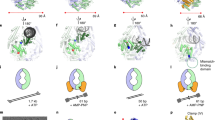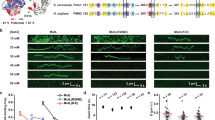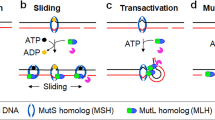Abstract
DNA mismatch repair detects and corrects mismatches introduced during DNA replication. The protein MutS scans for mismatches and coordinates the repair cascade. During this process, MutS undergoes multiple conformational changes in response to ATP binding, hydrolysis and release, but how ATP induces the various MutS conformations is incompletely understood. Here we present four cryogenic electron microscopy structures of Escherichia coli MutS at sequential stages of the ATP hydrolysis cycle that reveal how ATP binding and hydrolysis induce closing and opening of the MutS dimer, respectively. Biophysical analysis demonstrates how DNA binding modulates the ATPase cycle by prevention of hydrolysis during scanning and mismatch binding, while preventing ADP release in the sliding clamp state. Nucleotide release is achieved when MutS encounters single-stranded DNA that is produced during removal of the daughter strand. The combination of ATP binding and hydrolysis and its modulation by DNA enables MutS to adopt the different conformations needed to coordinate the sequential steps of the mismatch repair cascade.
This is a preview of subscription content, access via your institution
Access options
Access Nature and 54 other Nature Portfolio journals
Get Nature+, our best-value online-access subscription
$29.99 / 30 days
cancel any time
Subscribe to this journal
Receive 12 print issues and online access
$189.00 per year
only $15.75 per issue
Buy this article
- Purchase on Springer Link
- Instant access to full article PDF
Prices may be subject to local taxes which are calculated during checkout





Similar content being viewed by others
Data availability
Cryo-EM maps and atomic models have been deposited in the Electron Microscopy Database and Protein Data Bank, respectively, under accession code nos. EMD-13073, PDB 7OU2, EMD-13074, PDB 7OU4, EMD-13063, PDB 7OTO, EMD-13071 and PDB 7OU0. Source data for the graphs in Figs. 3 and 4 are available with the paper online. Other requests should be addressed to Meindert Lamers (m.h.lamers@lumc.nl). Source data are provided with this paper.
References
Li, Z., Pearlman, A. H. & Hsieh, P. DNA mismatch repair and the DNA damage response. DNA Repair (Amst.) 38, 94–101 (2016).
Jiricny, J. Postreplicative mismatch repair. Cold Spring Harb. Perspect. Biol. 5, a012633 (2013).
Welsh, K. M., Lu, A. L., Clark, S. & Modrich, P. Isolation and characterization of the Escherichia coli mutH gene product. J. Biol. Chem. 262, 15624–15629 (1987).
Junop, M. S., Yang, W., Funchain, P., Clendenin, W. & Miller, J. H. In vitro and in vivo studies of MutS, MutL and MutH mutants: correlation of mismatch repair and DNA recombination. DNA Repair (Amst.) 2, 387–405 (2003).
Hall, M. C. & Matson, S. W. The Escherichia coli MutL protein physically interacts with MutH and stimulates the MutH-associated endonuclease activity. J. Biol. Chem. 274, 1306–1312 (1999).
Kadyrov, F. A., Dzantiev, L., Constantin, N. & Modrich, P. Endonucleolytic function of MutLα in human mismatch repair. Cell 126, 297–308 (2006).
Fukui, K., Nishida, M., Nakagawa, N., Masui, R. & Kuramitsu, S. Bound nucleotide controls the endonuclease activity of mismatch repair enzyme MutL. J. Biol. Chem. 283, 12136–12145 (2008).
Pluciennik, A. et al. PCNA function in the activation and strand direction of MutL endonuclease in mismatch repair. Proc. Natl Acad. Sci. USA 107, 16066–16071 (2010).
Pillon, M. C., Miller, J. H. & Guarné, A. The endonuclease domain of MutL interacts with the β sliding clamp. DNA Repair (Amst.) 10, 87–93 (2011).
Yang, H., Yung, M., Sikavi, C. & Miller, J. H. The role of Bacillus anthracis RecD2 helicase in DNA mismatch repair. DNA Repair (Amst.) 10, 1121–1130 (2011).
Walsh, B. W. et al. RecD2 helicase limits replication fork stress in Bacillus subtilis. J. Bacteriol. 196, 1359–1368 (2014).
Burdett, V., Baitinger, C., Viswanathan, M., Lovett, S. T. & Modrich, P. In vivo requirement for RecJ, ExoVII, ExoI, and ExoX in methyl-directed mismatch repair. Proc. Natl Acad. Sci. USA 98, 6765–6770 (2001).
Yamaguchi, M., Dao, V. & Modrich, P. MutS and MutL activate DNA helicase II in a mismatch-dependent manner. J. Biol. Chem. 273, 9197–9201 (1998).
Lahue, R. S., Au, K. G. & Modrich, P. DNA mismatch correction in a defined system. Science 245, 160–164 (1989).
Goellner, E. M., Putnam, C. D. & Kolodner, R. D. Exonuclease 1-dependent and independent mismatch repair. DNA Repair (Amst.) 32, 24–32 (2015).
Schofield, M. J., Nayak, S., Scott, T. H., Du, C. & Hsieh, P. Interaction of Escherichia coli MutS and MutL at a DNA Mismatch. J. Biol. Chem. 276, 28291–28299 (2001).
Acharya, S., Foster, P. L., Brooks, P. & Fishel, R. The coordinated functions of the E. coli MutS and MutL proteins in mismatch repair. Mol. Cell 12, 233–246 (2003).
Gradia, S. et al. hMSH2-hMSH6 forms a hydrolysis-independent sliding clamp on mismatched DNA. Mol. Cell 3, 255–261 (1999).
Blackwell, L. J., Bjornson, K. P., Allen, D. J. & Modrich, P. Distinct MutS DNA-binding modes that are differentially modulated by ATP binding and hydrolysis. J. Biol. Chem. 276, 34339–34347 (2001).
Heo, S. D., Cho, M., Ku, J. K. & Ban, C. Steady-state ATPase activity of E. coli MutS modulated by its dissociation from heteroduplex DNA. Biochem. Biophys. Res. Commun. 364, 264–269 (2007).
Jeong, C. et al. MutS switches between two fundamentally distinct clamps during mismatch repair. Nat. Struct. Mol. Biol. 18, 379–385 (2011).
Fernandez-Leiro, R. et al. The selection process of licensing a DNA mismatch for repair. Nat. Struct. Mol. Biol. 28, 373–381 (2021).
Hingorani, M. M. Mismatch binding, ADP-ATP exchange and intramolecular signaling during mismatch repair. DNA Repair (Amst.) 38, 24–31 (2016).
Davies, D. R. & Hol, W. G. J. The power of vanadate in crystallographic investigations of phosphoryl transfer enzymes. FEBS Lett. 577, 315–321 (2004).
Lamers, M. H. et al. The crystal structure of DNA mismatch repair protein MutS binding to a G x T mismatch. Nature 407, 711–717 (2000).
Obmolova, G., Ban, C., Hsieh, P. & Yang, W. Crystal structures of mismatch repair protein MutS and its complex with a substrate DNA. Nature 407, 703–710 (2000).
Kato, R., Kataoka, M., Kamikubo, H. & Kuramitsu, S. Direct observation of three conformations of MutS protein regulated by adenine nucleotides. J. Mol. Biol. 309, 227–238 (2001).
Hura, G. L. et al. Comprehensive macromolecular conformations mapped by quantitative SAXS analyses. Nat. Methods 10, 453–454 (2013).
Qiu, R. et al. Large conformational changes in MutS during DNA scanning, mismatch recognition and repair signalling. EMBO J. https://doi.org/10.1038/emboj.2012.95 (2012).
Sharma, A., Doucette, C., Biro, F. N. & Hingorani, M. M. Slow conformational changes in MutS and DNA direct ordered transitions between mismatch search, recognition and signaling of DNA repair. J. Mol. Biol. 425, 4192–4205 (2013).
Lamers, M. H. et al. ATP increases the affinity between MutS ATPase domains: Implications for ATP hydrolysis and conformational changes. J. Biol. Chem. 279, 43879–43885 (2004).
Nirwal, S., Kulkarni, D. S., Sharma, A., Rao, D. N. & Nair, D. T. Mechanism of formation of a toroid around DNA by the mismatch sensor protein. Nucleic Acids Res. 46, 256–266 (2018).
Groothuizen, F. S. et al. MutS/MutL crystal structure reveals that the MutS sliding clamp loads MutL onto DNA. eLife 4, e06744 (2015).
Hopfner, K. P. Invited review: architectures and mechanisms of ATP binding cassette proteins. Biopolymers 105, 492–504 (2016).
Hol, W. G. J. The role of the α-helix dipole in protein function and structure. Prog. Biophys. Mol. Biol. 45, 149–195 (1985).
Hopfner, K. P. & Tainer, J. A. Rad50/SMC proteins and ABC transporters: unifying concepts from high-resolution structures. Curr. Opin. Struct. Biol. 13, 249–255 (2003).
Acharya, S. Mutations in the signature motif in MutS affect ATP-induced clamp formation and mismatch repair. Mol. Microbiol. 69, 1544–1559 (2008).
Bjornson, K. P., Allen, D. J. & Modrich, P. Modulation of MutS ATP hydrolysis by DNA cofactors. Biochemistry 39, 3176–3183 (2000).
Antony, E. & Hingorani, M. M. Asymmetric ATP binding and hydrolysis activity of the Thermus aquaticus MutS dimer is key to modulation of its interactions with mismatched DNA. Biochemistry 43, 13115–13128 (2004).
Lamers, M., Winterwerp, H. & Sixma, T. The alternating ATPase domains of the DNA mismatch repair enzyme MutS control DNA mismatch repair. EMBO J. 22, 746–756 (2003).
Hopfner, K. P. et al. Structural biology of Rad50 ATPase: ATP-driven conformational control in DNA double-strand break repair and the ABC-ATPase superfamily. Cell 101, 789–800 (2000).
Zhou, Y., Ojeda-May, P. & Pu, J. H-loop histidine catalyzes ATP hydrolysis in the E. coli ABC-transporter HlyB. Phys. Chem. Chem. Phys. 15, 15811–15815 (2013).
Groothuizen, F. S. et al. Using stable MutS dimers and tetramers to quantitatively analyze DNA mismatch recognition and sliding clamp formation. Nucleic Acids Res. 41, 8166–8181 (2013).
Mazur, D. J., Mendillo, M. L. & Kolodner, R. D. Inhibition of Msh6 ATPase activity by mispaired DNA induces a Msh2(ATP)-Msh6(ATP) state capable of hydrolysis-independent movement along DNA. Mol. Cell 22, 39–49 (2006).
Galio, L., Bouquet, C. & Brooks, P. ATP hydrolysis-dependent formation of a dynamic ternary nucleoprotein complex with MutS and MutL. Nucleic Acids Res. 27, 2325–2331 (1999).
Biswas, I. & Vijayvargia, R. Heteroduplex DNA and ATP induced conformational changes of a MutS mismatch repair protein from Thermus aquaticus. Biochem. J. 347, 881–886 (2000).
Cristóvão, M. et al. Single-molecule multiparameter fluorescence spectroscopy reveals directional MutS binding to mismatched bases in DNA. Nucleic Acids Res. 40, 5448–5464 (2012).
Iaccarino, I., Marra, G., Palombo, F. & Jiricny, J. hMSH2 and hMSH6 play distinct roles in mismatch binding and contribute differently to the ATPase activity of hMutSα. EMBO J. 17, 2677–2686 (1998).
Studamire, B., Quach, T. & Alani, E. Saccharomyces cerevisiae Msh2p and Msh6p ATPase activities are both required during mismatch repair. Mol. Cell. Biol. 18, 7590–7601 (1998).
Monti, M. C. et al. Native mass spectrometry provides direct evidence for DNA mismatch-induced regulation of asymmetric nucleotide binding in mismatch repair protein MutS. Nucleic Acids Res. 39, 8052–8064 (2011).
Gradia, S., Acharya, S. & Fishel, R. The human mismatch recognition complex hMSH2-hMSH6 functions as a novel molecular switch. Cell 91, 995–1005 (1997).
Hao, P. et al. Recurrent mismatch binding by MutS mobile clamps on DNA localizes repair complexes nearby. Proc. Natl Acad. Sci. USA 117, 17775–17784 (2020).
LeBlanc, S. J. et al. Coordinated protein and DNA conformational changes govern mismatch repair initiation by MutS. Nucleic Acids Res. 46, 10782–10795 (2018).
Au, K. G., Welsh, K. & Modrich, P. Initiation of methyl-directed mismatch repair. J. Biol. Chem. 267, 12142–12148 (1992).
Luna-Vargas, M. P. A. et al. Enabling high-throughput ligation-independent cloning and protein expression for the family of ubiquitin specific proteases. J. Struct. Biol. 175, 113–119 (2011).
Feng, G. & Winkler, M. E. Single-step purifications of His6-MutH, His6-MutL and His6-MutS repair proteins of escherichia coli K-12. Biotechniques 19, 956–965 (1995).
Zivanov, J. et al. New tools for automated high-resolution cryo-EM structure determination in RELION-3. eLife 7, e42166 (2018).
Zheng, S. Q. et al. MotionCor2: anisotropic correction of beam-induced motion for improved cryo-electron microscopy. Nat. Methods 14, 331–332 (2017).
Zhang, K. gCTF: real-time CTF determination and correction. J. Struct. Biol. 193, 1–12 (2016).
Emsley, P., Lohkamp, B., Scott, W. G. & Cowtan, K. Features and development of Coot. Acta Crystallogr. D Biol. Crystallogr. 66, 486–501 (2010).
Murshudov, G. N. et al. REFMAC5 for the refinement of macromolecular crystal structures. Acta Crystallogr. D Biol. Crystallogr. 67, 355–367 (2011).
Nicholls, R. A., Tykac, M., Kovalevskiy, O. & Murshudov, G. N. Current approaches for the fitting and refinement of atomic models into cryo-em maps using CCP-EM. Acta Crystallogr. D Struct. Biol. 74, 492–505 (2018).
Liebschner, D. et al. Macromolecular structure determination using X-rays, neutrons and electrons: recent developments in Phenix. Acta Crystallogr. D Struct. Biol. 75, 861–877 (2019).
Pettersen, E. F. et al. UCSF Chimera – a visualization system for exploratory research and analysis. J. Comput. Chem. 25, 1605–1612 (2004).
Venkata Subramaniya, S. R. M., Terashi, G. & Kihara, D. Super resolution Cryo-EM maps with 3D deep generative networks. Preprint at bioRxiv https://doi.org/10.1101/2021.01.12.426430 (2021).
Nicholls, R. A., Fischer, M., Mcnicholas, S. & Murshudov, G. N. Conformation-independent structural comparison of macromolecules with ProSMART. Acta Crystallogr. D Biol. Crystallogr. 70, 2487–2499 (2014).
Williams, C. J. et al. MolProbity: more and better reference data for improved all-atom structure validation. Protein Sci. 27, 293–315 (2018).
Rohou, A. & Grigorieff, N. CTFFIND4: fast and accurate defocus estimation from electron micrographs. J. Struct. Biol. 192, 216–221 (2015).
Acknowledgements
We thank the staff of the LUMC EM facility and NeCEN for help with data collection and data processing. We thank R. Fernandez-Leiro for advice on data processing. This work was supported by a LUMC Research Fellowship to M.H.L., and a European Community’s Horizon2020 Innovative Training Network Grant (no. 722433) to M.H.L. and P.F. Access to NeCEN was supported by Netherlands Electron Microscopy Infrastructure (project no. 184.034.014) of the National Roadmap for Large-Scale Research Infrastructure of the Dutch Research Council.
Author information
Authors and Affiliations
Contributions
M.H.L. and A.B. conceived the overall experimental design. A.B. prepared samples and collected and processed cryo-EM data. A.B. purified proteins and performed BLI experiments. P.F. and V.K. designed and analyzed FRET experiments. V.K. performed FRET experiments, which were supervised by P.F. A.B. and M.H.L. wrote the manuscript with contributions from all authors.
Corresponding author
Ethics declarations
Competing interests
The authors declare no competing interests.
Peer review information
Nature Structural and Molecular Biology thanks Jean-Baptiste Charbonnier and Keith Weninger for their contribution to the peer review of this work. Carolina Perdigoto and Beth Moorefield were the primary editors on this article and managed its editorial process and peer review in collaboration with the rest of the editorial team. Peer reviewer reports are available.
Additional information
Publisher’s note Springer Nature remains neutral with regard to jurisdictional claims in published maps and institutional affiliations.
Extended data
Extended Data Fig. 1 CryoEM data analysis of ADP bound MutS.
a, Representative micrograph. b, 2D class averages from full dataset. c, Schematic representation of main data processing procedures. See methods section for more details. d, Fourier Shell Correlation between half-maps from subsequent refinements in the processing procedures. e, Detail of model fit to map. f, Final map obtained applying SuperEM code to Relion post-processed map. g, final map colored by local resolution. h, Orientation distribution in final set of refined particles.
Extended Data Fig. 2 CryoEM data analysis of ADP-ATP bound MutS.
a, Representative micrograph. b, 2D class averages from full dataset. c, Schematic representation of main data processing procedures. See methods section for more details. d, Fourier Shell Correlation between half-maps from subsequent refinements in the processing procedures. e, Detail of model fit to map. f, Final map obtained applying SuperEM code to Relion post-processed map. g, final map colored by local resolution. h, Orientation distribution in final set of refined particles.
Extended Data Fig. 3 CryoEM data analysis of ANPPNP bound MutS.
a, Representative micrograph. b, 2D class averages from full dataset. c, Schematic representation of main data processing procedures. See methods section for more details. d, Fourier Shell Correlation between half-maps from subsequent refinements in the processing procedures. e, Detail of model fit to map. f, Final map obtained applying SuperEM code to Relion post-processed map. g, final map colored by local resolution. h, Orientation distribution in final set of refined particles.
Extended Data Fig. 4 CryoEM data analysis of ADP-Vi bound MutS.
a, Representative micrograph. b, 2D class averages from full dataset. c, Schematic representation of main data processing procedures. See methods section for more details. d, Fourier Shell Correlation between half-maps from subsequent refinements in the processing procedures. e, Detail of model fit to map. f, Superimposition of nucleotide binding domains of MutS in ADP-Vi conformation and MutS in sliding clamp MutL bound conformation (Fernandez-Leiro 2021). g, Final map obtained applying SuperEM code to Relion post-processed map. h, final map colored by local resolution. i, Orientation distribution in final set of refined particles.
Supplementary information
Supplementary Information
Supplementary Tables 1 and 2 and references.
Supplementary Video 1
Side view of ATPase domain closing upon binding of ATP and AMPPNP.
Supplementary Video 2
Top view of ATPase domain closing upon binding of ATP and AMPPNP.
Supplementary Video 3
Overview of conformational changes in MutS upon ATP and AMPPNP binding.
Source data
Rights and permissions
About this article
Cite this article
Borsellini, A., Kunetsky, V., Friedhoff, P. et al. Cryogenic electron microscopy structures reveal how ATP and DNA binding in MutS coordinates sequential steps of DNA mismatch repair. Nat Struct Mol Biol 29, 59–66 (2022). https://doi.org/10.1038/s41594-021-00707-1
Received:
Accepted:
Published:
Issue Date:
DOI: https://doi.org/10.1038/s41594-021-00707-1
This article is cited by
-
Tandem regulation of MutS activity by ATP and DNA during MMR initiation
Nature Structural & Molecular Biology (2022)
-
MutS and MutL sliding clamps in DNA mismatch repair
Genome Instability & Disease (2022)



